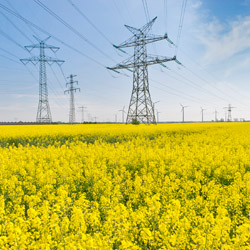Transmission network

An electric power system includes electricity generation in power plants, transmission and distribution networks and consumers of electricity. Transmission network transports electricity from generators to areas of concentrated consumption, where in distribution transformer substations distribution networks or the largest consumers, such as iron works or aluminium productions, are connected. The transmission network consists of overhead power lines, sometimes underground cable networks and distribution or distribution transformer substations. Transmission network operates at a high voltage level for efficient transmission of large power over long distances. In European countries, most voltage levels used in the transmission system are 110 kV, 220 kV and 400 kV. Transmission networks also serve as links between national electricity systems of different countries; we call them interconnectors. Interconnection of the transmission systems began already before the market opening and was mainly intended to support electric power systems. After opening of the markets, interconnections enable cross-border electricity trade.
The transmission network is operated by the electricity TSO, which is responsible for maintenance and development of the system and secure, reliable and efficient operation of the entire electric power system, as well as maintaining the balance between production and consumption, including also cross-border transmissions (import and export).







